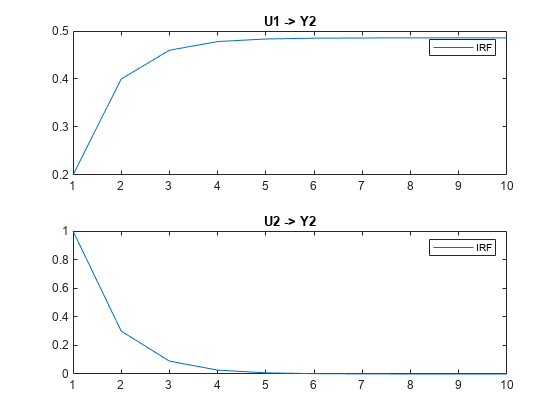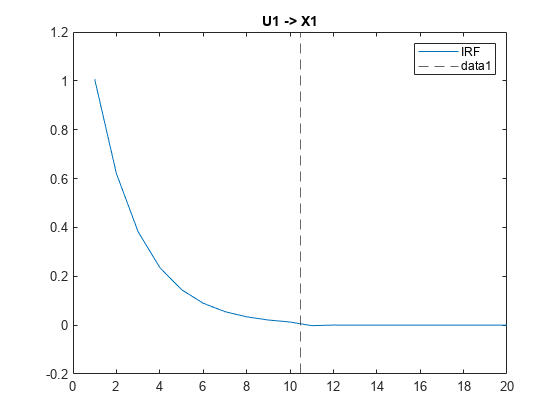irfplot
Plot impulse response function (IRF) of state-space model
Syntax
Description
irfplot plots the IRFs of the state and measurement variables in a state-space model. To return the IRFs as numeric arrays instead, use irf. Other state-space model tools to characterize the dynamics of a specified system include:
The forecast error variance decomposition (FEVD), computed by
fevd, provides information about the relative importance of each state disturbance in affecting the forecast error variance of all measurement variables in the system.Model-implied temporal correlations, computed by
corrfor a standard state-space model, measure the association between present and past state or measurement variables, as prescribed by the form of the model.
Fully Specified State-Space Model
irfplot( plots the IRF, or dynamic response, of each state and measurement variable of the fully specified state-space model Mdl)Mdl, such as an estimated model. irfplot plots a figure containing the IRFs of the measurement variables yt, and plots a separate figure containing the IRFs of the state variables xt. Each figure contains a subplot for each variable and state disturbance combination; subplot (i,j) is the IRF of variable j resulting from a unit shock applied to a state disturbance i
ui,t. Subplot titles identify the shocked variable and IRF variable.
irfplot( uses additional options specified by one or more name-value pair arguments. For example, Mdl,Name,Value)'PlotU',1:2,'PlotX',[] plots only the measurement variable IRFs resulting from shocks applied to the first and second state-disturbance variables (the state variable IRF plot is suppressed).
Partially Specified State-Space Model and Confidence Interval Estimation
irfplot(___, also plots pointwise lower and upper 95% Monte Carlo confidence bounds in each plot. 'Params',estParams,'EstParamCov',EstParamCov)EstParamCov specifies the estimated covariance matrix of the parameter estimates, as returned by the estimate function, and is required for confidence interval estimation.
Customize Figures
irfplot( plots on the axes objects specified by ax,___)ax instead of new figures. The option ax can precede any of the input argument combinations in the previous syntaxes.
Examples
Input Arguments
Name-Value Arguments
Output Arguments
More About
Algorithms
If you specify
'eigendecomposition'for the'Method'name-value pair argument,irfplotattempts to diagonalize the state-transition matrix A by using the spectral decomposition.irfplotresorts to recursive multiplication instead under at least one of these circumstances:An eigenvalue is complex.
The rank of the matrix of eigenvectors is less than the number of states
Mdlis time varying.
irfplotuses Monte Carlo simulation to compute confidence intervals.irfplotrandomly drawsNumPathsvariates from the asymptotic sampling distribution of the unknown parameters inMdl, which is Np(Params,EstParamCov), where p is the number of unknown parameters.For each randomly drawn parameter set j,
irfplot:Creates a state-space model that is equal to
Mdl, but substitutes in parameter set jComputes the random IRF of the resulting model ψj(t), where t = 1 through
NumPaths
For each time t, the lower bound of the confidence interval is the
(1 –quantile of the simulated IRF at period t ψ(t), wherec)/2cConfidence. Similarly, the upper bound of the confidence interval at time t is the(1 –upper quantile of ψ(t).c)/2
Version History
Introduced in R2020b






